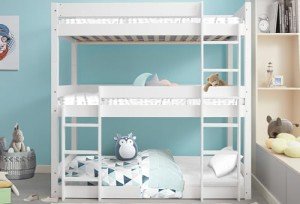A Comprehensive Guide to Children's Bunk Beds: Styles, Benefits, and Safety Considerations
Bunk beds have become a popular choice for families aiming to maximize space and supply a fun sleeping environment for kids. With their special design, they use an imaginative and practical solution for shared bed rooms, playrooms, or even guest lodging. This short article checks out the numerous styles of children's bunk beds, their benefits, security factors to consider, and addresses some frequently asked concerns.
The Allure of Bunk Beds
Kid's bunk beds are more than simply space-saving structures; they are likewise a gateway to adventurous dreams and creative play. Below is a detailed evaluation of their many advantages.
Advantages of Bunk Beds
- Space-Saving: Bunk beds efficiently make use of vertical space, making them a perfect option for smaller spaces.
- Lively Design: Many bunk bed designs include slides, tents, and themed elements, triggering imagination and enjoyment.
- Partner Sharing: Bunk beds are best for siblings sharing a space or accommodating sleepovers.
- Versatile Use: Some models can be separated into two private beds, using versatility as kids grow.
- Storage Options: Many bunk beds feature built-in drawer storage or racks, even more enhancing their usefulness.
Styles of Children's Bunk Beds
The variety of bunk beds offered today caters to different preferences and requirements. Below is an overview of some popular designs.
| Design | Description | Best For |
|---|---|---|
| Requirement Bunk Bed | A conventional style featuring one bed stacked above another. | Brother or sisters sharing a room. |
| Loft Bed | Similar to a bunk bed without the bottom bunk, permits a work space or play area listed below. | Restricted space for play/desk. |
| L-Shaped Bunk Bed | Two beds organized in an L-shape, often with additional areas for storage or play. | Special space layouts. |
| Twin Over Full | A twin bed over a complete bed, accommodating different sleep requirements. | Growing kids and teens. |
| High Sleeper | Stands even higher than a loft bed, normally including a desk or play area listed below. | Older kids needing more play/desk space. |
| Camping Tent Bunk Bed | Bunk beds with a canopy or tent-like structure, developing a relaxing, enjoyable space. | Active and imaginative children. |
Key Features to Consider
When picking the best bunk bed for kids, the following functions deserve thinking about:
- Material: Bunk beds can be made from wood, metal, or a combination. Each has its unique visual and toughness.
- Weight Capacity: Always validate the weight limitation of the bunk bed to ensure it can accommodate your kids securely.
- Safety Rails: Ensure the leading bunk has tough rails to avoid falls.
- Ladder Security: A well-designed ladder needs to offer simple and safe access to the upper bunk.
- Completing: Ensure any surfaces are non-toxic and safe for children.
Safety Considerations
Safety is vital when it concerns kids's bunk beds. The following guidelines need to be stuck to:
- Age Appropriateness: Generally, kids under 6 years old ought to not oversleep the upper bunk due to security threats.
- Durable Construction: Ensure the frame and products are solid and can support the weight without drooping.
- Regular Maintenance: Periodically look for loose screws, bolts, or other parts that may need tightening.
- Clear Play Area: Keep the location around the bunk bed complimentary of toys and challenges to minimize tripping dangers.
Setting Rules for Safe Use
Establishing standards for bunk bed use will assist make sure security:
- Limit Jumping and Climbing: Children should be recommended against jumping from the leading bunk and climbing up on the sides.
- Supervising Sleepovers: Monitor young guests while they are using the bunk bed for the very first time.
- Educate on Ladder Use: Teach how to utilize the ladder securely, stressing the importance of dealing with the ladder when climbing or down.
Regularly Asked Questions
1. What www.bunkbedsstore.top is appropriate for a child to sleep in the top bunk?
A lot of manufacturers recommend that children should be at least 6 years old to oversleep the upper bunk. This standard is created to alleviate the danger of falls.
2. Can bunk beds be personalized?
Yes, lots of manufacturers use customizable alternatives, consisting of colors, products, and additional functions like drawers or desks.
3. Are bunk beds safe for weight?
Bunk beds have weight limits, typically varying from 200 to 400 pounds, depending upon the design and product. Always check the producer's specs.
4. How do I keep and clean up a bunk bed?
Frequently check for loose parts, keep the bed tidy by wiping down surface areas, and make sure the bed linen is fresh to promote a safe and sanitary sleep environment.
5. Can bunk beds be separated into individual beds?
Numerous bunk beds feature a choice to separate them into two individual beds, supplying long-term versatility.
Kid's bunk beds are more than simple furniture; they are a functional, versatile, and imaginative component of a kid's space. With various designs offered and various safety factors to consider to keep in mind, moms and dads can select the best bed that fits their space, meets their kids's needs, and imparts a sense of adventure. By understanding the benefits, designs, and safety procedures related to bunk beds, families can produce a wonderful and safe sleeping environment for their children. Whether for brother or sisters sharing a space or space-saving services, bunk beds remain a precious choice for lots of homes.

